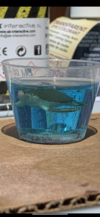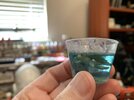All I have a general question. I tried doing an underwater resin diorama for the fist time and it turned out badly. When the resin cured I ended up with a foamy bubbly mess-(see pictures below) I carefully measured it out as instructed in the right ration of 2:1 resin to catalyst/hardener .
See the before and after pictures below. Any ideas what might have gone wrong here? I used AK Resin Water.





See the before and after pictures below. Any ideas what might have gone wrong here? I used AK Resin Water.


